
- November 21, 2025
- By: Massey Ferguson Zimbabwe
- in: Agricultural Machinery, Farm Equipment, Massey Ferguson Tractors

For Zimbabwean farmers, both smallholder and commercial, the period after harvest is critical. Efficient post harvest management determines the final profitability of their crop. The maize thresher has become a vital piece of machinery, transforming a labor intensive process into a streamlined operation that boosts efficiency, improves grain quality, and enhances financial returns.
Maize threshers support farmers by rapidly separating kernels from cobs, a task that once took days or even weeks by hand. This speed is crucial during the busy harvest season. Key features define their performance. Throughput capacity, which measures how much maize a machine can process per hour, is a primary consideration. Power sources vary to suit different scales of operation. Some models are driven by a tractor’s power take off, or PTO, making them ideal for commercial farms with existing equipment. Others use small petrol or diesel engines, offering flexibility for smallholder farmers and cooperative groups.
The design of these machines emphasizes durability to withstand the demanding conditions of farm use. Ease of maintenance is another important factor, ensuring farmers can perform routine checks and minor repairs without significant downtime. Safety considerations are also built into modern designs to protect operators. Access to reliable spare parts and service from local dealerships ensures that machinery remains operational when it is needed most, providing farmers with peace of mind and necessary operator training.
Typical use cases for maize threshers are diverse. Beyond basic shelling and cleaning, their mobility allows them to be moved directly to the fields, reducing the need to transport bulky cobs over long distances. This on farm mobility is particularly beneficial for large estates and scattered smallholdings. Cooperative ownership models are also gaining traction, where a group of farmers pools resources to purchase and share a thresher, making mechanisation more affordable.
Proper operation is essential for maximising grain quality and minimising losses. The seasonal timing, immediately following the harvest, requires careful planning. Farmers must ensure their maize is properly dried to an optimal moisture level before threshing. This practice significantly reduces grain damage, such as cracking or breaking, which can lower the market value of the crop. Correct setup and consistent operation of the thresher according to manufacturer guidelines are best practices that further protect the harvest’s integrity.
Ultimately, access to dependable maize threshers through a network of trusted local suppliers empowers Zimbabwean farmers. By mechanising a key post harvest task, they can secure a higher quality product, reduce labour costs, and get their grain to market faster, strengthening the entire agricultural value chain.

Post a Comment